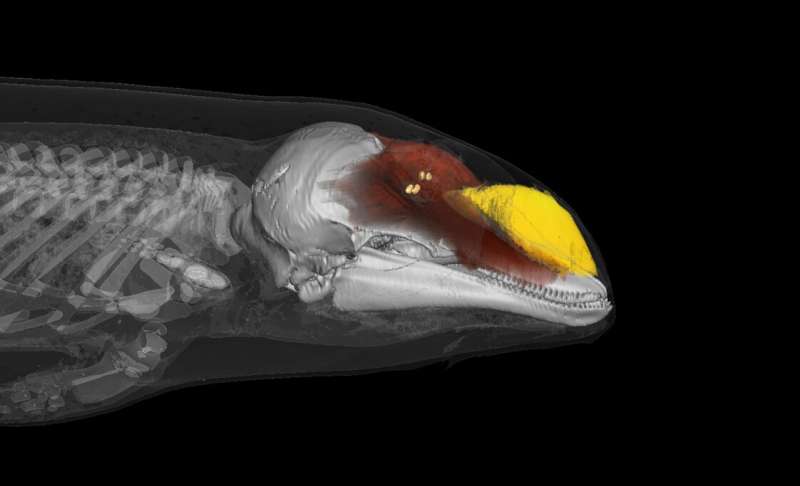This article has been reviewed according to Science X's editorial process and policies. Editors have highlighted the following attributes while ensuring the content's credibility:
fact-checked
peer-reviewed publication
trusted source
proofread
Toothed whales catch food in the deep using vocal fry register

Dolphins and other toothed whales are large brained top predators that captivate our imagination; they are extremely social, they cooperate, and can hunt prey down to 2 km deep in complete darkness with echolocation.
All these remarkable behaviors are mediated using sound that travels far and fast in murky and dark waters. However, it has remained a mystery how these amazing animals make their rich vocal repertoires in the deep.
Now a new study in the journal Science reports that toothed whales evolved an air-driven nasal sound source that operates at different vocal registers like the human voice.
The study was led by Professor Coen Elemans, voice scientist at the Department of Biology, University of Southern Denmark and Professor Peter Madsen, whale biologist at the Department of Biology, Aarhus University in Denmark.
The study shows that toothed whales, like humans, have at least three voice registers; the vocal fry register (also known as creaky voice, which produces the lowest tones), the chest register (which is our normal speaking voice) and the falsetto register (which produces even higher frequencies).
"Vocal fry is a normal voice register that is often used in American English. Kim Kardashian, Kate Perry and Scarlet Johannsen are well-known people using this register," Professor Elemans says.
According to the new research, toothed whales use this vocal fry register to produce their echolocation calls to catch prey.
"During vocal fry, the vocal folds are only open for a very short time, and therefore it takes very little breathing air to use this register," Elemans adds.
"And this air-economy makes it especially ideal for echolocation," says Professor Madsen, adding:
"During deep dives, all air is compressed to a tiny fraction of the volume on the surface."
Toothed whales dive as deep as 2,000 meters and catch more fish than the human fishing industry. When they hunt in the deep and murky waters, they produce short, powerful, ultrasonic echolocation clicks at rates up to 700 per second to locate, track and catch prey.
"Thus vocal fry allows whales access to the richest food niches on earth; the deep ocean," says Madsen.
"While vocal fry may be controversial in humans and may be perceived as everything from annoying to authoritative, it doubtlessly made toothed whales an evolutionary success story," Elemans adds.
It was previously thought that toothed whales make sounds with their larynx just as other mammals, but 40 years ago it became clear that this is not the case; they somehow use their nose to produce sound. In the new study, the Danish research team has uncovered, what exactly goes on using high-speed video through endoscopes:
The toothed whales have evolved an air-driven sound production system in their nose, that functions physically analogous to laryngeal and syringeal sound production in mammals and birds—but its location is far from the same.
"Evolution has moved it from the trachea into the nose, which allowed much higher driving pressures—up to five times what a trumpet player can generate—without damaging lung tissues," says Madsen.
"This high driving pressure allows toothed whales to make the loudest sounds of any animal on the planet," Elemans adds.
At depths over 100m, whale lungs collapse to avoid compression sickness and are thus no good for air supply, and the remaining air is found in the nasal passages of the skull. This provides a small, but sufficient airspace to produce echolocating sound at astonishing depths of 2000 meters.
When echolocating, toothed whales pressurize air in their bony nose and lets it pass structures called phonic lips that vibrate just as human vocal folds. Their acceleration produces sound waves that travel through the skull to the front of the head.
In addition to echolocation, toothed whales make a huge array of sounds for their complex social communication.
"Some species, like killer and pilot whales, make very complex calls that are learned and passed on culturally like human dialects," says Madsen.
In their study, the researchers show that these sounds are made by the phonic lips vibrating in the chest and falsetto registers. They filmed the phonic lips using several different approaches, using both trained dolphins and animals in the wild that were moving freely with a small tag that recorded their sounds. The in vivo recordings were done at Dolfinarium Harderwijk in Holland.
"It took us close to 10 years to develop new techniques, gather and analyze all our data," says Elemans.
More information: Peter T. Madsen et al, Toothed whales use distinct vocal registers for echolocation and communication, Science (2023). DOI: 10.1126/science.adc9570. www.science.org/doi/10.1126/science.adc9570
Journal information: Science
Provided by University of Southern Denmark





















